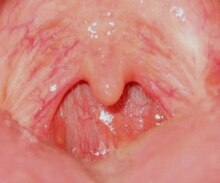Soft palate

The soft palate ( Latin velum palatinum ) is a continuation of the hard palate in mammals in the form of a double fold. It is also known as the soft palate ( palatum molle ). The soft palate hangs down obliquely or vertically in the direction of the root of the tongue and is formed from extensions of the palatopharyngeal muscle and other muscle radiation. It partially delimits the oral cavity from the pharynx and thus serves to delimit the air and food routes .
anatomy
The soft palate is covered on the side facing the oral cavity with an uncornified squamous epithelium and on the side facing the nasopharynx with a respiratory (ciliated) epithelium. In many mammals, lymphoid tissue in the form of the tonsilla veli palatini (soft palate almond) is embedded in the mucous membrane on the underside . This almond is not developed in humans or predators . On the underside of the soft palate, bundles of glands , the palatine glands , are embedded in the mucous membrane , which represent salivary glands .
The soft palate is mainly moved by the pharyngeal constrictor muscle , the tensor veli palatini muscle and the levator veli palatini muscle . On both sides, two double folds, the so-called palatal arches, start from the edge of the soft palate . At the free edge of the soft palate in monkeys and humans the uvula protrudes conically in the middle . Most other mammals do not develop it.
The soft palate is innervated by the glossopharyngeal nerve ( cranial nerve IX) and the vagus nerve (cranial nerve X), which form a pharyngeal plexus . The blood supply is provided by the descending palatine arteries and ascending palatine arteries .
The line of attachment of the soft palate is called the "Ah line". It owes its name to the fact that it becomes visible when saying a long "Ahhhs". It is used by dental technicians as a posterior limit for full dentures .
function
The soft palate partially delimits the oral cavity from the pharynx and thus serves to delimit the air and food ducts. During the act of swallowing , the soft palate is pressed by the pharyngeal constrictor muscle against the annular bulge on the back of the pharynx. The tensor and levator veli palatini muscles arise on the tubal cartilage and also ensure that the pressure between the outside world and the middle ear is equalized when swallowing or yawning .
In the articulation , the soft palate lifts and places at the throat rear wall, whereby the nasal cavity from the mouth and throat is separated and coming out of the lungs Phonationsstrom can flow only through the throat and mouth, so that oral sounds arise ( velopharyngeal closure ). With nasal consonants, the oral cavity is closed and the phonation current flows off through the nose. With nasalized vowels , the soft palate lowers and allows the phonation current to flow through both the oral cavity and the nasal cavity.
The soft palate also plays a role in snoring . Surgical shortening can in rare cases improve snoring. However, (as when the palate-R z. Can after surgery difficulties in forming the sound [ ʁ ] ) occur or move parts of the food during swallowing in the nasopharynx. Most health insurance companies do not pay for such an operation.
Clinical significance
The soft palate is of greater practical importance in the surgical reconstruction of cleft lips, jaws and palates or in tumor operations .
literature
- Franz-Viktor Salomon: soft palate . In the S. u. a. (Ed.): Anatomy for veterinary medicine . 2nd ext. Ed. Enke-Verlag, Stuttgart 2008, pp. 268-269, ISBN 978-3-8304-1075-1 .
